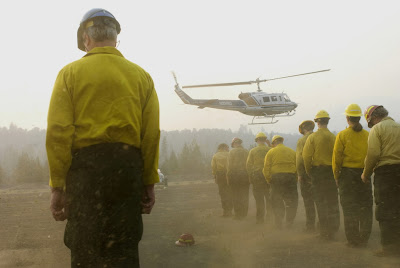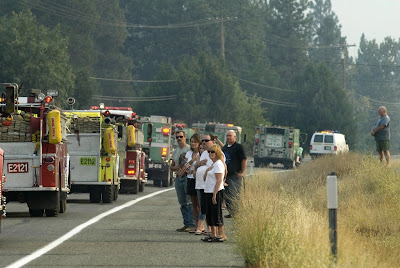William Coultas, the pilot of the helicopter that crashed on Tuesday with 13 on board in northern California, is still in critical but stable condition. He has had skin graft surgery for severe burns.
Firefighters' remains removed from crash site
On Sunday the remains of the last four firefighters who died Tuesday at the crash site were removed on flag-draped stretchers and flown by helicopter back to a helibase where they were met by a bagpiper and a 22-person honor guard of firefighters. Engines, law enforcement vehicles, and ambulances then escorted a van with the remains to the Coroner's office in Weaverville where they will be identified.


Cockpit voice recorder being analyzed
The voice recorder from the helicopter that crashed was made in the UK and can't be analyzed by the NTSB in the United States. It has been sent to the British company that made it.
Memorial services
Jim Ramage, the U.S. Forest Service check pilot who died in the helicopter crash, will be remembered in a memorial service on August 16 in Redding, California.
The firefighters employed by Grayback Forestry who perished in the crash will be remembered in a service August 15 in Medford, Oregon.
"Heat rises"
The 20th anniversary of the 1988 fires in the Yellowstone area has generated a lot of interest. We have seen a number of articles on the topic from a wide variety of authors--some more informed about wildland fires than others.
In attempting to explain the complex process of how vegetation can continue to exist following a fire, one article summed it up this way:
Bulbs and other underground roots often survive and germinate again after large fires because heat rises.[sigh]
There will be a major conference to commemorate the 1988 fires in Jackson Hole, Wyoming Sept. 22-27. I am fairly certain that none of the speakers at the conference will sum up fire succession by saying "heat rises".
No grudge held against grizzly after attack
Tony Allabastro, 26, the member of the Lewis and Clark Hot Shots that was attacked by a grizzly bear while conducting a burnout on the LeHardy fire in Yellowstone NP, said the bear was just trying to escape from the fire. He was treated for scrapes on his back and thighs at the clinic in the park, was on light duty for a few days, then returned to the fireline.
Allabastro said he and four other firefighters were setting a backburn when he heard "a little snap. I look up and there's a bear taking a few steps toward me."Real time tracking of retardant drops
Allabastro said he began walking away, but when he turned to look over his shoulder, the bear was running at him at full speed.
"I instinctively started running as well," he said.
The bear chased Allabastro about 8 feet to a pile of logs, then swatted him in the shoulder a few times. Allabastro said he tried to crawl underneath the logs, but the bear pulled him out. Then, standing on Allabastro's thighs, the bear reared up on its hind legs and slammed his front paws down on his shoulders.
"It did that once, maybe twice," he said.
Then the bear ran off.
"It does seem kind of surreal at this point," Allabastro said. "It makes you a little more aware when you are walking through the woods."
Allabastro, a Chicago native, has been living in Missoula for eight years. This is his first season with the Lewis and Clark Hot Shots.
Land management agencies have been tracking in real time the location of firefighting aircraft, including air tankers and helicopters, for several years, but Latitude Technologies is conducting a test of a system that tracks individual retardant drops by airtankers. Each drop can then be displayed on maps on monitors back at the incident command post. The system is being tested on the Canada-based Martin Mars air tanker which is under contract this year with CalFire. The mammoth aircraft was used extensively in the Siege of '88 in northern California.
High firefighting costs shut down USFS projects
The U.S. Forest Service has already spent all of their budget for firefighting, and is taking funds from other programs to continue firefighting for the rest of the fiscal year, ending September 30. The Chief of the USFS, Abigail Kimbell, is suspending spending on all contracts and projects except in emergency or critical circumstances.
As an example, they are blaming the high costs of firefighting as the reason funds are not available to repair a popular road to a Mount St. Helens viewpoint. Last week they announced Forest Road 99 to Windy Ridge will remain closed through the end of the year. The viewpoint usually gets about 100,000 visitors a year, but the road was closed by a washout from rainstorms late last year.
Reward offered for arson fires in Idaho
A $5,000 reward is being offered for information leading to the conviction of the individual responsible for a series of wildland fires in southeastern Idaho. Arson fires, ranging in size from 10 to 10,000 acres, have plagued the area during the last few summers.
Photos courtesy of Oregonlive




No comments:
Post a Comment